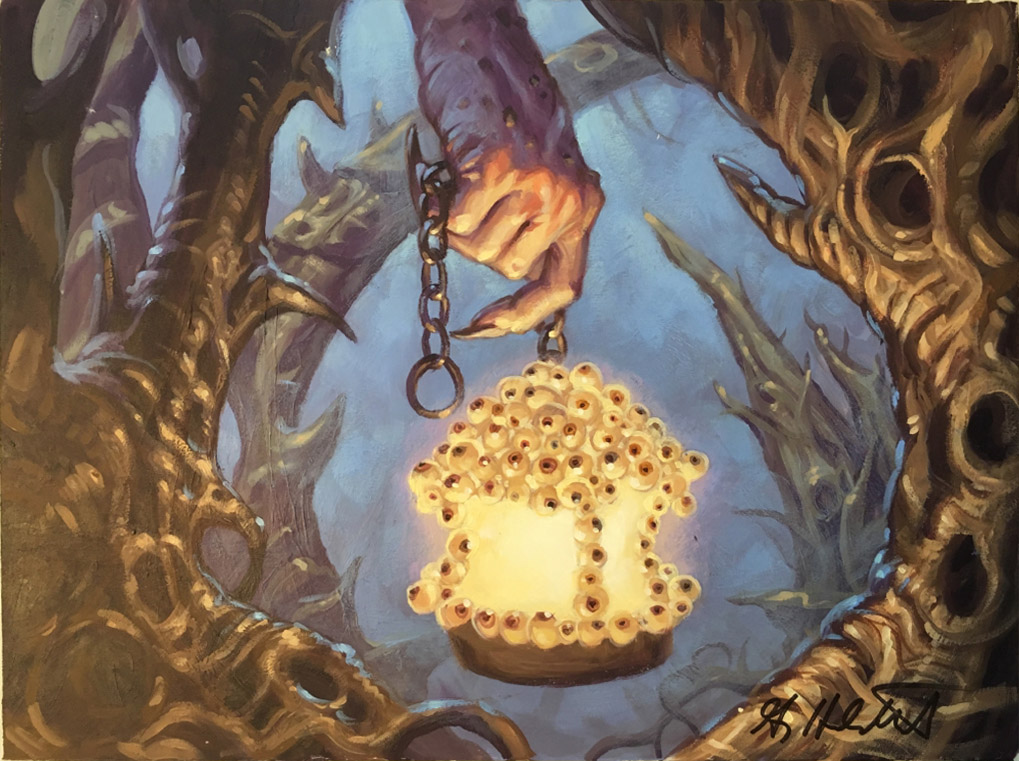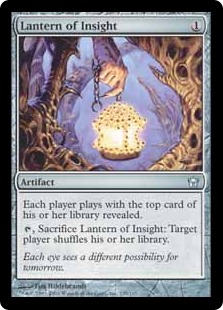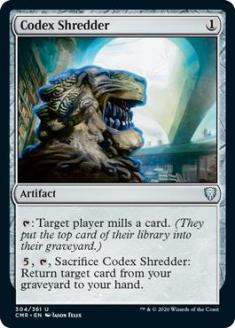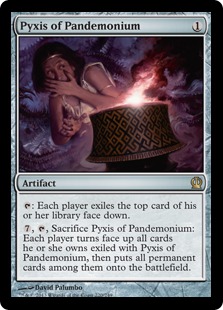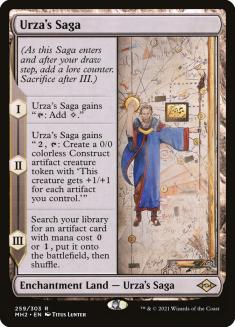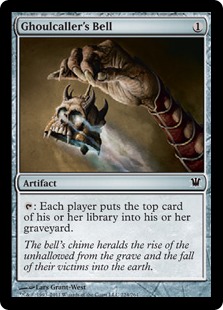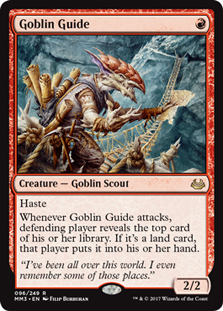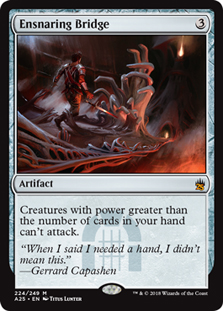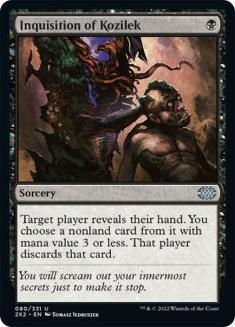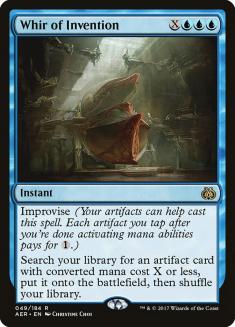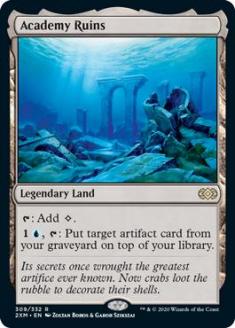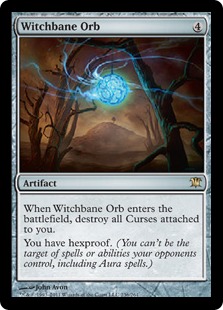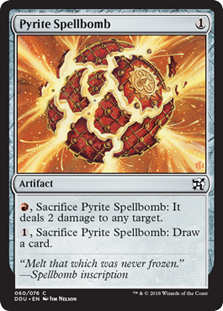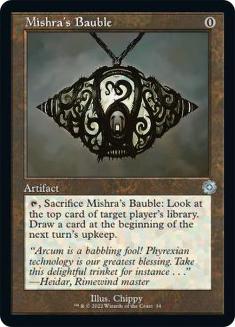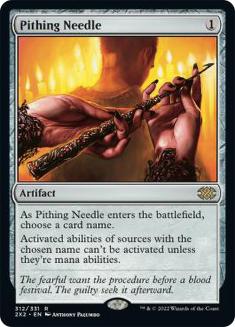When Lantern Control was first introduced to the world, it looked like a meme — a collection of such unusual and ordinarily unplayable cards couldn’t produce a competitive Modern deck. Soon the world learned that it was wrong, and Lantern became an established Modern archetype that would show up eventually with varying degrees of popularity, culminating in a Pro Tour win by Luis Salvatto. I wasn’t one of the early adopters of the deck, but I adopted it once it became a known quantity, playing it in a Grand Prix and testing it for several other tournaments.
With the Mox Opal ban, Lantern Control basically disappeared from the Modern metagame. With the advent of Urza’s Saga, it’s now back on the menu! Here are three sample lists from recent Modern events:
Lands (22)
Spells (38)

Creatures (2)
Planeswalkers (2)
Lands (21)
Spells (35)
- 2 Ensnaring Bridge
- 4 Lantern of Insight
- 3 Talisman of Dominance
- 1 Pyrite Spellbomb
- 1 Welding Jar
- 2 Pithing Needle
- 1 Sword of the Meek
- 2 Thoughtseize
- 1 Relic of Progenitus
- 1 Thopter Foundry
- 3 Inquisition of Kozilek
- 1 Torpor Orb
- 1 Witchbane Orb
- 1 Grafdigger's Cage
- 4 Codex Shredder
- 1 Pyxis of Pandemonium
- 2 Collective Brutality
- 4 Whir of Invention

Planeswalkers (2)
Lands (21)
Spells (37)

Urza’s Saga does a couple of distinct but very important things for the deck. The first thing it does is tutor up your missing combo pieces. Lantern of Insight, Codex Shredder, and Pyxis of Pandemonium are your combo, and Urza’s Saga finds them all. It’s impossible to overstate how strong it is to have your land turn into a part of your combo for free in the middle of the game, and that’s the main reason the deck is strong again.
The second reason is that you can make Constructs, and rather big ones in this deck, since a lot of the deck is cheap artifacts. In Game 1, Ensnaring Bridge can render the Constructs obsolete, but you’re still a deck with Inquisition of Kozilek, Thoughtseize, and some removal spells, and sometimes your draw will line up in a way where they’re just dead to the Constructs and you don’t even get to cast Ensnaring Bridge. Besides, they at least get to block; sometimes even with Ensnaring Bridge a creature gets through (such as Noble or Ignoble Hierarch), and having a big blocker can be beneficial.
In Game 2 and Game 3, however, the Construct becomes much better, because people will have fewer removal spells against you, so killing the opponent with one or two of them becomes much easier. What’s a hypothetical control player going to do? Keep Path to Exile in their deck? Urza’s Saga offers an alternate win condition in the form of a land that costs nothing to play because it’s part of your combo already, and this flexibility is also invaluable.
The third use of the card is to find bullets. Lantern Control traditionally is interested in playing certain hate cards such as Grafdigger’s Cage and Pithing Needle; with Urza’s Saga, you have a lot more access to them (since you can also Ancient Stirrings for either piece).
So, we’ve established that Urza’s Saga is very powerful in Lantern control. But is it powerful enough to basically resurrect the deck? I think so.
Before we delve into the specifics of the list, I want to talk a bit about how this deck works to begin with. If you’re not aware of how it plays out, it’ll look like a random assortment of cards to you, and even if you understand what it’s trying to do, a lot of the interactions can be quite tricky.
At its core, Lantern Control is a prison deck. The goal is to lock the opponent out of the game. It does so by virtue of having Lantern of Insight, which means both players play with the top card of their libraries revealed, and then cards that can mill the opponent every turn — Codex Shredder, Pyxis of Pandemonium, or Ghoulcaller’s Bell (also called the “mill rocks”). If you have Lantern of Insight and one of these mill artifacts out, you have control over what your opponent is going to draw. If it’s a good card, you mill it. Otherwise, you let them have it.
Normally, when you reach this point of the game, your opponent will have certain cards that matter and certain cards that don’t. For example, if they have ten lands out, clearly another Plains is a card that doesn’t matter, so you can let them draw it freely. In my mind, I think of the cards that matter as the “universe of cards that matter”. Each turn of the game where they draw a card that doesn’t matter is a win for you. Given enough of those in a row, you will win the game by default. A lot of the time, if they draw a card that matters, you lose the game on the spot.
When you have Lantern of Insight and some number of mill rocks, you’re not getting rid of their draw step; they’re still drawing a card, just not that specific card. Because of this, it’s entirely possible that you see a good card on top, mill it away, and then there’s another good card on top right after that. Your goal is to get to a scenario where this is not possible because the universe of cards that matter is smaller than the amount of mills you have access to. You can do this by either increasing the amount of mill rocks you have or by making the universe of cards that matter smaller (which is usually done via other lock pieces, such as Ensnaring Bridge, Pithing Needle, Grafdigger’s Cage, and Surgical Extraction).
Imagine, as a simplification, a scenario in which you’re at two life and your opponent’s library consists of two copies of Lightning Bolt, two copies of Goblin Guide, and two Mountains. In this scenario, the universe of cards that matter is four cards — the Lightning Bolts and the Goblin Guides will kill you, and the Mountains do nothing. If you have Lantern out with a single Codex Shredder, if the opponent sees two of these killer cards in a row, you lose the game. (You don’t technically lose right away, since you can sacrifice the Lantern to shuffle, but you’re not in a good spot; they could just draw the card again and now you’ve lost your ability to mill them in future turns. Still, for this exercise, let’s assume you lose.)
VS
If all you have is one Codex Shredder, you lose the game every time two of these cards appear in a row (which, in a six-card deck, is actually guaranteed to happen at some point).
Now, imagine you have an extra mill rock — say, another Codex Shredder. Now, you only lose the game if three of these cards are in a sequence, since you can get rid of two of them, which is not guaranteed to happen at all.
Going back to the one-mill-rock scenario, imagine that, instead of having an extra mill rock, you have an Ensnaring Bridge on the battlefield. Now, you’ve narrowed the universe of cards that matter; since Goblin Guide can’t attack, you’re totally fine with your opponent drawing it, and the only two cards that matter are the two Lightning Bolts. At this point, you’re a big favorite to win (you’ll only lose if the two Lightning Bolts are right next to each other).
VS
And now, imagine that you have both the Ensnaring Bridge and a second mill rock. In this spot, the universe of cards that matter is two, and the amount of mill rocks you have is also two. Therefore, at this point, it’s no longer possible for you to lose the game — you’ve achieved an actual lock. Getting to this point is your goal in every game.
Of course, in reality things are a bit more complex than this. If you have an untapped Codex Shredder at the end of their turn, for example, that effectively acts as an extra mill. So, in the scenario where you have the Ensnaring Bridge, if you can dodge them drawing Lightning Bolt for one turn, you’re going to win the game, because as long as your Codex Shredder is untapped it can mill two sequential Lightning Bolts. Thus, in practice, you don’t need quite as many mill rocks to establish a lock.
As a counterpoint, if they have any cantrips, then you need extra mill rocks. For example, imagine the same scenario but your opponent has Sunbaked Canyon on the battlefield. Here, if you only have one Codex Shredder and they see Lightning Bolt on top, you’re dead, because they can simply sacrifice their Sunbaked Canyon in response to you milling them.
The biggest strength of this deck is that it’s an Ensnaring Bridge deck, and Ensnaring Bridge is one of the best cards in Magic to reduce the universe of cards that matter, especially when you can so easily empty your hand and especially in Game 1. Ensnaring Bridge is the type of card that tends to create a sub-game of “Can they deal with Ensnaring Bridge?”, which is the perfect scenario for a Lantern Control deck to find itself in. Most of the time, when you cast Ensnaring Bridge versus a creature deck, the universe of cards that matter becomes about 10% what it was before, at which point one or two mill rocks are usually enough to effectively win the game.
You also have to consider the fact that, sometimes your opponent already has a card that can beat you. For example, imagine they had Shatterstorm and four lands in their opening hand. In this spot, you can manipulate their draws all you want and it’s not going to help you. You might also be in a scenario where you don’t actually know what the universe of cards that matter is, because you don’t know what is in their hand.
Imagine your opponent is playing Mono-Green Tron and have six mana on the battlefield with one card in hand. You see a land on top of their library. Is that card a threat? Is it part of the universe that matters? It’s impossible to know, because their card in hand could be, for example, Karn Liberated. If it is, and you let them draw a land, you’re going to lose the game. However, you could mill that land “just to be sure” and then draw them into Karn Liberated itself, when their last card in hand was the land.
To solve both of these scenarios, the deck packs a ton of discard spells — Inquisition of Kozilek, Thoughtseize, and sometimes Collective Brutality. This gives information about your opponent’s hand while also making sure the game is about the top of their library rather than what they already had.
Another issue is that, sometimes, there’s a card that matters a little bit but it’s not game-ending, so you have to evaluate the likelihood you lose the game to this card versus the likelihood they will find something worse. For example, imagine your opponent reveals a Noble Hierarch when you’re at eight life or so. Noble Hierarch is a card that matters (it can attack through Ensnaring Bridge), but if you have eight turns to find an answer for it, you probably will. If your opponent has cards that actually win them the game (e.g. ways to answer Ensnaring Bridge) and you’re limited in your mana rocks, you should probably give them the Hierarch and try to win through it.
Here, it pays off to know exactly what cards people are playing in each deck. You’ll never know exactly without decklists, and you don’t need to know the exact configuration everyone is playing, but it pays to know if, for example, people commonly play ways to destroy artifacts in the maindeck, or if they have direct damage you have to watch out for. If your opponent’s most threatening card is the Hierarch, you should mill it away even if you’re at twenty life; if they have dozens of more threatening cards, maybe you want to leave it there even if you’re at five.
Another important interaction in the deck is filtering your own draw steps, as your card is also revealed from Lantern of Insight and you can choose to mill it so you don’t draw it. Both Ghoulcaller’s Bell and Pyxis of the Pandemonium mill both players, so you can often get rid of a good card from them and a bad card from you at the same time, generating sort of a two-for-one with your activation.
In general, unless you’re desperately trying to find a specific card (such as an Ensnaring Bridge or a Grafdigger’s Cage), their library takes precedence over yours. This means that if you have a bad card (such as a redundant land or Inquisition of Kozilek) and they also have a bad card, it’s generally better to not activate Ghoulcaller’s Bell or Pyxis of Pandemonium because each turn they draw a card that doesn’t matter is a win for you, even if you also draw a card that doesn’t matter, and it’s often not worth the risk to give them a good card in search of a good card for yourself. Similarly, if your card is bad and their card is good and you have Codex Shredder, it’s better to mill them than to mill yourself.
Now, on to the list itself:
Most people nowadays play four copies of Whir of Invention in their Lantern Control lists, but I must admit I’m not a fan of the card right now. I already didn’t love it when you had Mox Opal as another blue source, and now you have four copies of a colorless land that you actively want to play early in the game, which means that even if you have UUU in spite of Urza’s Saga, the timing can be very awkward. It’s not only Whir itself that’s the problem either, as you have to play Botanical Sanctum and Darkslick Shores, which means you now have a lot of lands that only produce green or black (as opposed to having multicolored lands that produce both), so you might run into more spots where you want to cast Thoughtseize or Ancient Stirrings but can’t.
Overall I simply don’t think you need this card and I’d rather play more pieces of my combo cards.
I love Academy Ruins, and I usually played two copies in Lantern Control, but I think that without Mox Opal it’s hard enough to get “free” blue mana if you don’t play Whir that I lean towards not playing it right now. I have very low confidence that this is correct, though. It’s possible you should play a rainbow manabase and just try to support Academy Ruins with eight or fewer sources.
Witchbane Orb is capable of narrowing the universe of cards that matter quite well. However, it’s a four-mana card, and as a result it can be quite clunky. I think The Underworld Cookbook does a reasonable impression of getting you out of burn range while being tutorable by Urza’s Saga and helping empty your hand for Ensnaring Bridge. Even if you have Whir of Invention (which means you can tutor for Orb as well) I don’t like it as a maindeck card.
As a general rule, you don’t need a win condition; milling is enough to get the job done every time. It can still be useful to be able to find a removal spell with your Urza’s Saga, though, so Pyrite Spellbomb is a reasonable addition if you have access to red mana.
These cards are similar, except that Pyxis is better against some interactions, whereas Bell is better with your own synergies, such as Codex Shredder and Academy Ruins. Right now, I think there are enough people playing random graveyard synergies (such as Cauldron Familiar) that you want to deal with that Pyxis is just a better card (especially if you don’t play Academy Ruins). Besides, it’s certainly not common, but you can actually activate the seven-mana ability from Pyxis and if you do that you’re likely to win the game.
Mishra’s Bauble is obviously worse now that you don’t have access to Mox Opal, but it still plays a variety of different, small roles in the deck:
- It’s an easy-to-get-rid-of card for Ensnaring Bridge (you don’t need to sacrifice it if you’re trying to empty your hand).
- It is an artifact for your Constructs and Spire of Industry / Glimmervoid / Whir of Invention if you play those.
- It’s great at fixing your draws early on with the mill rocks, as you can look at your card and then mill it if it’s bad, effectively drawing two from the Bauble.
- It acts as a pseudo-Lantern of Insight because you can use it to see if you want to allow them their top card or not. If you have Academy Ruins, you can actually just put Bauble on top every turn until you find Lantern and it does a good impression of it.
- It gives you information about their hand before you cast Lantern. Sometimes, there are windows between you casting a discard spell and you casting a Lantern in which they will draw an unknown card. Imagine, for example, you have an Urza’s Saga that’s ready to go off next turn (and find Lantern) and you cast Thoughtseize. In this spot, you’ll know their hand and you’ll know every draw step they will ever have, except for the very next one. Not knowing one of their cards could put you in trouble (like the Tron scenario I mentioned before). Or, sometimes, you need to sacrifice your Lantern to shuffle a good card and then you’re blind as to the card they drew this turn. With Bauble, you can peek at that one card to make sure you have perfect information for the entire game.
Overall, even though we don’t have Mox Opal anymore, I think you should play four Mishra’s Baubles in this deck.
Pithing Needle is quite good in this deck because it also helps lower the universe of cards that matter. Even against decks where you’d normally not want Pithing Needle, you usually find a target. A Horizon Canopy-style land or even a fetchland can be problematic (they can shuffle if they see a bad draw) so getting rid of those can come up.
So, where does this leave us? Something like this:
Lands (22)
Spells (38)

I don’t think the list is perfect by any means (for instance, I’m still not convinced it’s not better to play a rainbow mana base for Academy Ruins and sideboard cards), but I know that, for now, I like the versions without Whir of Invention more than the ones with it.
All in all, Lantern Control is not an easy deck to play, but it’s also not as hard as it looks; it just operates on a separate difficulty angle as it’s perhaps the only deck in Magic that often gives you full information about everything. You know what is in everyone’s hands and what they’re about to draw at all times, so you don’t have to expect or predict anything, as you see everything before it’s coming and you’re never caught off-guard. Even if their top card is one you’ve never seen before, you can just read it and make an assessment before deciding if you’ll allow them to draw it or not, whereas most other decks will only find out about the card once it’s played.
Sometimes, though, having knowledge about the format and other decks is useful to know which cards are threatening in each deck so you can narrow the universe of cards that matter. As an example, you often draw Pithing Needle while there’s nothing on the battlefield to name, but you have to cast the Needle anyway because of Ensnaring Bridge, so you need to know what they can have in the future. Because of this, it pays off to study the metagame a bit more comprehensively if you’re going to play this deck.
Finally, it pays to practice with the deck because it means you’ll play faster. Sometimes people will just concede when they are effectively dead, but if they don’t, Lantern Control can be notoriously slow to close out the game, and practicing with it will speed up your motions and make sure you can finish the game on time. When you’re playing in person, you also sometimes have to be more forceful in milling your opponent. If you tell them you mill them and they’re just staring at the ceiling, you might want to bring their attention back to real life so they can mill their card and get on with it.
If you’re interested in playing this deck, I would not let these things deter you. Even though it’s admittedly miserable to play against, I’ve had a lot of fun playing with the deck once I practiced with it, as it gives you a ton of agency over everything that’s happening in the game and that can feel very satisfying (on top of, you know, being a pretty good deck right now).

